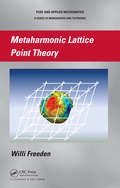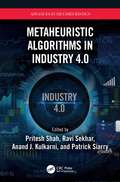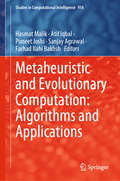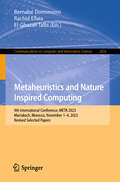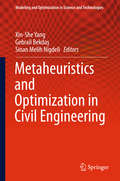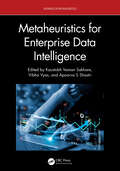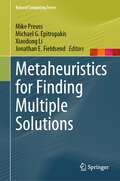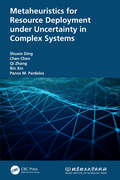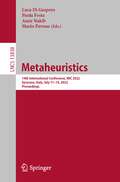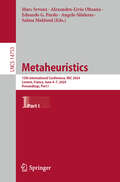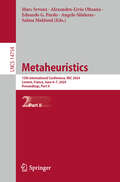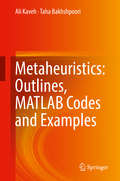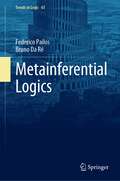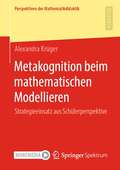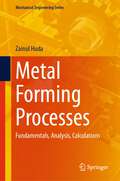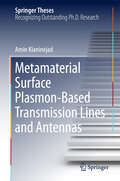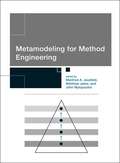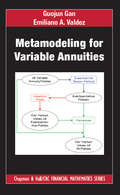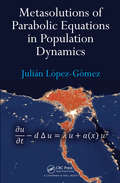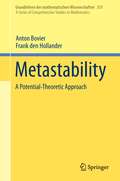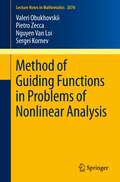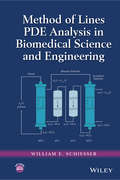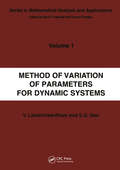- Table View
- List View
Metaharmonic Lattice Point Theory (Chapman & Hall Pure and Applied Mathematics)
by Willi FreedenMetaharmonic Lattice Point Theory covers interrelated methods and tools of spherically oriented geomathematics and periodically reflected analytic number theory. The book establishes multi-dimensional Euler and Poisson summation formulas corresponding to elliptic operators for the adaptive determination and calculation of formulas and identities of
Metaheuristic Algorithms in Industry 4.0 (Advances in Metaheuristics)
by Patrick Siarry Anand J. Kulkarni Pritesh Shah Ravi SekharDue to increasing industry 4.0 practices, massive industrial process data is now available for researchers for modelling and optimization. Artificial Intelligence methods can be applied to the ever-increasing process data to achieve robust control against foreseen and unforeseen system fluctuations. Smart computing techniques, machine learning, deep learning, computer vision, for example, will be inseparable from the highly automated factories of tomorrow. Effective cybersecurity will be a must for all Internet of Things (IoT) enabled work and office spaces. This book addresses metaheuristics in all aspects of Industry 4.0. It covers metaheuristic applications in IoT, cyber physical systems, control systems, smart computing, artificial intelligence, sensor networks, robotics, cybersecurity, smart factory, predictive analytics and more. Key features: Includes industrial case studies. Includes chapters on cyber physical systems, machine learning, deep learning, cybersecurity, robotics, smart manufacturing and predictive analytics. surveys current trends and challenges in metaheuristics and industry 4.0. Metaheuristic Algorithms in Industry 4.0 provides a guiding light to engineers, researchers, students, faculty and other professionals engaged in exploring and implementing industry 4.0 solutions in various systems and processes.
Metaheuristic and Evolutionary Computation: Algorithms and Applications (Studies in Computational Intelligence #916)
by Atif Iqbal Sanjay Agrawal Hasmat Malik Puneet Joshi Farhad Ilahi BakhshThis book addresses the principles and applications of metaheuristic approaches in engineering and related fields. The first part covers metaheuristics tools and techniques such as ant colony optimization and Tabu search, and their applications to several classes of optimization problems. In turn, the book’s second part focuses on a wide variety of metaheuristics applications in engineering and/or the applied sciences, e.g. in smart grids and renewable energy. In addition, the simulation codes for the problems discussed are included in an appendix for ready reference.Intended for researchers aspiring to learn and apply metaheuristic techniques, and gathering contributions by prominent experts in the field, the book offers readers an essential introduction to metaheuristics, its theoretical aspects and applications.
Metaheuristics and Nature Inspired Computing: 9th International Conference, META 2023, Marrakech, Morocco, November 1–4, 2023, Revised Selected Papers (Communications in Computer and Information Science #2016)
by Bernabé Dorronsoro El-Ghazali Talbi Rachid EllaiaThis book constitutes the refereed proceedings of the 9th International Conference on Metaheuristics and Nature Inspired Computing, META 2023, held in Marrakech, Morocco, during November 1-4, 2023. The 19 full papers presented in this volume were carefully reviewed and selected from 42 submissions. The papers are divided into the following topical sections: combinatorial optimization; scheduling; continuous optimization; automatic metaheuristics tuning; optimization and machine learning; and applications.
Metaheuristics and Optimization in Civil Engineering
by Xin-She Yang Gebrail Bekdaş Sinan Melih NigdeliThis timely book deals with a current topic, i. e. the applications of metaheuristic algorithms, with a primary focus on optimization problems in civil engineering. The first chapter offers a concise overview of different kinds of metaheuristic algorithms, explaining their advantages in solving complex engineering problems that cannot be effectively tackled by traditional methods, and citing the most important works for further reading. The remaining chapters report on advanced studies on the applications of certain metaheuristic algorithms to specific engineering problems. Genetic algorithm, bat algorithm, cuckoo search, harmony search and simulated annealing are just some of the methods presented and discussed step by step in real-application contexts, in which they are often used in combination with each other. Thanks to its synthetic yet meticulous and practice-oriented approach, the book is a perfect guide for graduate students, researchers and professionals willing to applying metaheuristic algorithms in civil engineering and other related engineering fields, such as mechanical, transport and geotechnical engineering. It is also a valuable aid for both lectures and advanced engineering students.
Metaheuristics for Enterprise Data Intelligence (Advances in Metaheuristics)
by Apoorva S Shastri Kaustubh Vaman Sakhare Vibha VyasWith the emergence of the data economy, information has become integral to business excellence. Every enterprise, irrespective of its domain of interest, carries and processes a lot of data in their day-to-day activities. Converting massive datasets into insightful information plays an important role in developing better business solutions. Data intelligence and its analysis pose several challenges in data representation, building knowledge systems, issue resolution and predictive systems for trend analysis and decisionmaking. The data available could be of any modality, especially when data is associated with healthcare, biomedical, finance, retail, cybersecurity, networking, supply chain management, manufacturing, etc. The optimization of such systems is therefore crucial to leveraging the best outcomes and conclusions. To this end, AI-based nature-inspired optimization methods or approximation-based optimization methods are becoming very powerful. Notable metaheuristics include genetic algorithms, differential evolution, ant colony optimization, particle swarm optimization, artificial bee colony, grey wolf optimizer, political optimizer, cohort intelligence and league championship algorithm. This book provides a systematic discussion of AI-based metaheuristics application in a wide range of areas, including big data intelligence and predictive analytics, enterprise analytics, graph optimization algorithms, machine learning and ensemble learning, computer vision enterprise practices and data benchmarking.
Metaheuristics for Finding Multiple Solutions (Natural Computing Series)
by Xiaodong Li Mike Preuss Michael G. Epitropakis Jonathan E. FieldsendThis book presents the latest trends and developments in multimodal optimization and niching techniques. Most existing optimization methods are designed for locating a single global solution. However, in real-world settings, many problems are “multimodal” by nature, i.e., multiple satisfactory solutions exist. It may be desirable to locate several such solutions before deciding which one to use. Multimodal optimization has been the subject of intense study in the field of population-based meta-heuristic algorithms, e.g., evolutionary algorithms (EAs), for the past few decades. These multimodal optimization techniques are commonly referred to as “niching” methods, because of the nature-inspired “niching” effect that is induced to the solution population targeting at multiple optima. Many niching methods have been developed in the EA community. Some classic examples include crowding, fitness sharing, clearing, derating, restricted tournament selection, speciation, etc. Nevertheless, applying these niching methods to real-world multimodal problems often encounters significant challenges.To facilitate the advance of niching methods in facing these challenges, this edited book highlights the latest developments in niching methods. The included chapters touch on algorithmic improvements and developments, representation, and visualization issues, as well as new research directions, such as preference incorporation in decision making and new application areas. This edited book is a first of this kind specifically on the topic of niching techniques.This book will serve as a valuable reference book both for researchers and practitioners. Although chapters are written in a mutually independent way, Chapter 1 will help novice readers get an overview of the field. It describes the development of the field and its current state and provides a comparative analysis of the IEEE CEC and ACM GECCO niching competitions of recent years, followed by a collection of open research questions and possible research directions that may be tackled in the future.
Metaheuristics for Resource Deployment under Uncertainty in Complex Systems
by Panos M. Pardalos Qi Zhang Chen Chen Shuxin Ding Bin XinMetaheuristics for Resource Deployment under Uncertainty in Complex Systems analyzes how to set locations for the deployment of resources to incur the best performance at the lowest cost. Resources can be static nodes and moving nodes while services for a specific area or for customers can be provided. Theories of modeling and solution techniques are used with uncertainty taken into account and real-world applications used. The authors present modeling and metaheuristics for solving resource deployment problems under uncertainty while the models deployed are related to stochastic programming, robust optimization, fuzzy programming, risk management, and single/multi-objective optimization. The resources are heterogeneous and can be sensors and actuators providing different tasks. Both separate and cooperative coverage of the resources are analyzed. Previous research has generally dealt with one type of resource and considers static and deterministic problems, so the book breaks new ground in its analysis of cooperative coverage with heterogeneous resources and the uncertain and dynamic properties of these resources using metaheuristics. This book will help researchers, professionals, academics, and graduate students in related areas to better understand the theory and application of resource deployment problems and theories of uncertainty, including problem formulations, assumptions, and solution methods.
Metaheuristics: 14th International Conference, MIC 2022, Syracuse, Italy, July 11–14, 2022, Proceedings (Lecture Notes in Computer Science #13838)
by Luca Di Gaspero Paola Festa Mario Pavone Amir NakibThis book constitutes the refereed proceedings of the 14th International Conference on Metaheuristics, MIC 2022, held in Syracuse, Italy, in July 2022.The 48 full papers together with 17 short papers presented were carefully reviewed and selected from 72 submissions. The papers detail metaheuristic techniques.
Metaheuristics: 15th International Conference, MIC 2024, Lorient, France, June 4–7, 2024, Proceedings, Part I (Lecture Notes in Computer Science #14753)
by Marc Sevaux Angelo Sifaleras Alexandru-Liviu Olteanu Eduardo G. Pardo Salma MakboulThis volume constitutes the refereed proceedings of Metaheuristics on 15th International Conference, MIC 2024, held in Lorient, France, during June 4–7, 2024. The 36 full papers presented together with 34 short papers were carefully reviewed and selected from 127 submissions. The conference focuses on artificial intelligence, combinatorial optimization, computer science, graph theory, evolutionary algorithms, genetic algorithms, simulated annealing, optimization, optimization problems.
Metaheuristics: 15th International Conference, MIC 2024, Lorient, France, June 4–7, 2024, Proceedings, Part II (Lecture Notes in Computer Science #14754)
by Marc Sevaux Angelo Sifaleras Alexandru-Liviu Olteanu Eduardo G. Pardo Salma MakboulThis volume constitutes the refereed proceedings of Metaheuristics on 15th International Conference, MIC 2024, held in Lorient, France, during June 4–7, 2024. The 36 full papers presented together with 34 short papers were carefully reviewed and selected from 127 submissions. The conference focuses on artificial intelligence, combinatorial optimization, computer science, graph theory, evolutionary algorithms, genetic algorithms, simulated annealing, optimization, optimization problems.
Metaheuristics: Outlines, MATLAB Codes and Examples
by Ali Kaveh Taha BakhshpooriThe book presents eight well-known and often used algorithms besides nine newly developed algorithms by the first author and his students in a practical implementation framework. Matlab codes and some benchmark structural optimization problems are provided. The aim is to provide an efficient context for experienced researchers or readers not familiar with theory, applications and computational developments of the considered metaheuristics. The information will also be of interest to readers interested in application of metaheuristics for hard optimization, comparing conceptually different metaheuristics and designing new metaheuristics.
Metainferential Logics (Trends in Logic #61)
by Federico Pailos Bruno Da RéThis book is the first to present a comprehensive investigation of the technical features of the metainferential logics developed in the last years, with their most relevant results and applications. It provides some new paths to define and investigate metainferential logics and offers a thorough study of the semantics and the proof-theories of this new and exciting variety of families of logics.This volume examines the hierarchies of metainferential logics and gives a general and systematic theory of them, and of the truth theories based on these logics. This book puts forward the prospects for truth-theories based on the metainferential logics of the TS/ST hierarchy and argues for its promise noting that each of these logics can be safely expanded with a transparent truth predicate. It also goes onto to explore new developments in three fields related to logics – namely metainferential logics built by means of the Weak Kleene schema and combining them with logics defined through the Strong Kleene schema, proof-theoretic presentations, and those with a with a global or an absolutely global validity standard, instead of a local one. This book is of interest to scholars in formal logic.
Metakognition beim mathematischen Modellieren: Strategieeinsatz aus Schülerperspektive (Perspektiven der Mathematikdidaktik)
by Alexandra KrügerIn der Arbeit werden die Sichtweisen von Schülerinnen und Schülern auf den Einsatz metakognitiver Strategien in der Gruppenarbeit beim mathematischen Modellieren analysiert. Im Fokus der Analysen stehen die Auslöser für den Einsatz metakognitiver Strategien und deren Auswirkungen aus Schülerperspektive. Dabei konnten Schülertypen metakognitiver Strategien rekonstruiert werden, die die Sichtweisen und Einstellungen der Schülerinnen und Schüler auf den Einsatz metakognitiver Strategien widerspiegeln. Auf Grundlage dieser Schülertypen werden Hinweise für geeignete Lehrerinterventionen zur Förderung des metakognitiven Strategieeinsatzes entwickelt.
Metal Forming Processes: Fundamentals, Analysis, Calculations (Mechanical Engineering Series)
by Zainul HudaThis unique textbook features fundamentals and analyses of metal forming processes supported by 200 worked numerical examples. It provides rigorous detail on the three all-important groups of metal-forming processes: bulk-metal forming, sheet-metal forming, and sheet-bulk-metal forming. Theory of metal forming is presented by discussing deformation behavior, plasticity, and formability with a thorough mathematical analyses and calculations. The mechanics of sheet metal forming is also covered by including principal strain increments in uniaxial loading as well as plane stress deformation. There are 125 diagrammatic illustrations/real-life photographs that have been labelled properly to enhance the understanding of readers. Among the salient features of the book is the inclusion of industrially-oriented projects, covering both technological and business considerations. The key solutions connected to these projects are presented with the aid of mathematical analysis and process flow diagrams. The book includes 100 multiple-choice questions (MCQs) with their answers and those for selected problems facilitating self-directed learning.
Metamaterial Surface Plasmon-Based Transmission Lines and Antennas (Springer Theses)
by Amin KianinejadThis thesis proposes a reliable and repeatable method for implementing Spoof Surface Plasmon (SSP) modes in the design of various circuit components. It also presents the first equivalent circuit model for plasmonic structures, which serves as an insightful guide to designing SSP-based circuits. Today, electronic circuits and systems are developing rapidly and becoming an indispensable part of our daily life; however the issue of compactness in integrated circuits remains a formidable challenge. Recently, the Spoof Surface Plasmon (SSP) modes have been proposed as a novel platform for highly compact electronic circuits. Despite extensive research efforts in this area, there is still an urgent need for a systematic design method for plasmonic circuits. In this thesis, different SSP-based transmission lines, antenna feeding networks and antennas are designed and experimentally evaluated. With their high field confinement, the SSPs do not suffer from the compactness limitations of traditional circuits and are capable of providing an alternative platform for the future generation of electronic circuits and electromagnetic systems.
Metamodeling for Method Engineering
by Manfred Jeusfeld Matthias Jarke John MylopoulosThis text is a guide to the foundations of method engineering, a developing field concerned with the definition of techniques for designing software systems. The approach is based on metamodeling, the construction of a model about a collection of other models. The book applies the metamodeling approach in five case studies, each describing a solution to a problem in a specific domain. Suitable for classroom use, the book is also useful as a reference for practitioners. The book first presents the theoretical basis of metamodeling for method engineering, discussing information modeling, the potential of metamodeling for software systems development, and the introduction of the metamodeling tool ConceptBase. The second, and larger, portion of the book reports on applications of the metamodeling approach to method engineering. These detailed case studies range from telecommunication service specification, hypermedia design, and data warehousing to cooperative requirements engineering, chemical device modeling, and design of new abstraction principles of modeling languages. Although these chapters can stand alone as case studies, they also relate to the earlier theoretical chapters. The metamodeling approach described in the book is based on the Telos metamodeling language implemented by the ConceptBase system. An accompanying CD-ROM contains the ConceptBase system and a large collection of Telos metamodels discussed in the text. The CD-ROM enables readers to start directly with method engineering, from small method chunks up to complete method definitions. The complete definition of Ed Yourdon's structured analysis method is included as an instructional example.
Metamodeling for Variable Annuities (Chapman and Hall/CRC Financial Mathematics Series)
by Guojun Gan Emiliano A. ValdezThis book is devoted to the mathematical methods of metamodeling that can be used to speed up the valuation of large portfolios of variable annuities. It is suitable for advanced undergraduate students, graduate students, and practitioners. It is the goal of this book to describe the computational problems and present the metamodeling approaches in a way that can be accessible to advanced undergraduate students and practitioners. To that end, the book will not only describe the theory of these mathematical approaches, but also present the implementations.
Metasolutions of Parabolic Equations in Population Dynamics
by Julián López-GómezMetasolutions of Parabolic Equations in Population Dynamics explores the dynamics of a generalized prototype of semilinear parabolic logistic problem. Highlighting the author's advanced work in the field, it covers the latest developments in the theory of nonlinear parabolic problems.The book reveals how to mathematically determine if a species maintains, dwindles, or increases under certain circumstances. It explains how to predict the time evolution of species inhabiting regions governed by either logistic growth or exponential growth. The book studies the possibility that the species grows according to the Malthus law while it simultaneously inherits a limited growth in other regions.The first part of the book introduces large solutions and metasolutions in the context of population dynamics. In a self-contained way, the second part analyzes a series of very sharp optimal uniqueness results found by the author and his colleagues. The last part reinforces the evidence that metasolutions are also categorical imperatives to describe the dynamics of huge classes of spatially heterogeneous semilinear parabolic problems. Each chapter presents the mathematical formulation of the problem, the most important mathematical results available, and proofs of theorems where relevant.
Metastability
by Anton Bovier Frank Den HollanderThis monograph provides a concise presentation of a mathematical approach to metastability, a wide-spread phenomenon in the dynamics of non-linear systems - physical, chemical, biological or economic - subject to the action of temporal random forces typically referred to as noise, based on potential theory of reversible Markov processes. The authors shed new light on the metastability phenomenon as a sequence of visits of the path of the process to different metastable sets, and focuses on the precise analysis of the respective hitting probabilities and hitting times of these sets. The theory is illustrated with many examples, ranging from finite-state Markov chains, finite-dimensional diffusions and stochastic partial differential equations, via mean-field dynamics with and without disorder, to stochastic spin-flip and particle-hop dynamics and probabilistic cellular automata, unveiling the common universal features of these systems with respect to their metastable behaviour. The monograph will serve both as comprehensive introduction and as reference for graduate students and researchers interested in metastability.
Method of Averaging for Differential Equations on an Infinite Interval: Theory and Applications (Lecture Notes in Pure and Applied Mathematics)
by Vladimir BurdIn recent years, mathematicians have detailed simpler proofs of known theorems, have identified new applications of the method of averaging, and have obtained many new results of these applications. Encompassing these novel aspects, Method of Averaging of the Infinite Interval: Theory and Applications rigorously explains the modern theory of the me
Method of Guiding Functions in Problems of Nonlinear Analysis
by Valeri Obukhovskii Sergei Kornev Nguyen Van Loi Pietro ZeccaThis book offers a self-contained introduction to the theory of guiding functions methods, which can be used to study the existence of periodic solutions and their bifurcations in ordinary differential equations, differential inclusions and in control theory. It starts with the basic concepts of nonlinear and multivalued analysis, describes the classical aspects of the method of guiding functions, and then presents recent findings only available in the research literature. It describes essential applications in control theory, the theory of bifurcations, and physics, making it a valuable resource not only for "pure" mathematicians, but also for students and researchers working in applied mathematics, the engineering sciences and physics.
Method of Lines PDE Analysis in Biomedical Science and Engineering
by William E. SchiesserPresents the methodology and applications of ODE and PDE models within biomedical science and engineering With an emphasis on the method of lines (MOL) for partial differential equation (PDE) numerical integration, Method of Lines PDE Analysis in Biomedical Science and Engineering demonstrates the use of numerical methods for the computer solution of PDEs as applied to biomedical science and engineering (BMSE). Written by a well-known researcher in the field, the book provides an introduction to basic numerical methods for initial/boundary value PDEs before moving on to specific BMSE applications of PDEs. Featuring a straightforward approach, the book's chapters follow a consistent and comprehensive format. First, each chapter begins by presenting the model as an ordinary differential equation (ODE)/PDE system, including the initial and boundary conditions. Next, the programming of the model equations is introduced through a series of R routines that primarily implement MOL for PDEs. Subsequently, the resulting numerical and graphical solution is discussed and interpreted with respect to the model equations. Finally, each chapter concludes with a review of the numerical algorithm performance, general observations and results, and possible extensions of the model. Method of Lines PDE Analysis in Biomedical Science and Engineering also includes: Examples of MOL analysis of PDEs, including BMSE applications in wave front resolution in chromatography, VEGF angiogenesis, thermographic tumor location, blood-tissue transport, two fluid and membrane mass transfer, artificial liver support system, cross diffusion epidemiology, oncolytic virotherapy, tumor cell density in glioblastomas, and variable grids Discussions on the use of R software, which facilitates immediate solutions to differential equation problems without having to first learn the basic concepts of numerical analysis for PDEs and the programming of PDE algorithms A companion website that provides source code for the R routines Method of Lines PDE Analysis in Biomedical Science and Engineering is an introductory reference for researchers, scientists, clinicians, medical researchers, mathematicians, statisticians, chemical engineers, epidemiologists, and pharmacokineticists as well as anyone interested in clinical applications and the interpretation of experimental data with differential equation models. The book is also an ideal textbook for graduate-level courses in applied mathematics, BMSE, biology, biophysics, biochemistry, medicine, and engineering.
Method of Variation of Parameters for Dynamic Systems
by V. LakshmikanthamMethod of Variation of Parameters for Dynamic Systems presents a systematic and unified theory of the development of the theory of the method of variation of parameters, its unification with Lyapunov's method and typical applications of these methods. No other attempt has been made to bring all the available literature into one volume. This book is a clear exposition of this important topic in control theory, which is not covered by any other text. Such an exposition finally enables the comparison and contrast of the theory and the applications, thus facilitating further development in this fascinating field.
Methode der Randelemente in Statik und Dynamik
by Lothar Gaul Christian FiedlerDie gut eingeführte Methode der Randelemente baut auf den Grundlagen der Kontinuumsmechnik auf. In diesem Buch wird sie für die Elastodynamik schwingender Strukturen und für die Elastostatik formuliert. Die mathematischen und ingenieurwissenschaftlichen Grundlagen werden bereitgestellt; einfache Beispiele erleichtern das Verständnis. Das Buch liegt nun in einer 2. korrigierten Auflage vor. Es richtet sich an Studierende, Ingenieure und Naturwissenschaftler, die sich Kenntnisse der Randelementmethode erarbeiten wollen.
